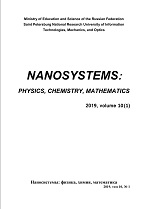|
This article is cited in 4 scientific papers (total in 4 papers)
PHYSICS
High-temperature superconductivity: From macroto nanoscale structures
A. N. Kovalenko
Ioffe Institute, St. Petersburg, Russia
Abstract:
The analysis of achievements, problems and prospects of high-temperature superconductivity (HTSC) in the macro- and nanostructured materials has been given. The main experimental results and theoretical models describing the physical mechanisms of the superconductivity appearance at phenomenological and microscopic levels, including change in the energy spectrum of atoms in these materials with the advent of the“superconducting” gap at temperatures below the critical transition, as well as the above-critical temperature “pseudo-gap” have been analyzed. Although the origin of the pseudo-gap is not completely understood, it can be considered as an independent phase transition in the substance prior to the transition to the zero resistance state and insusceptibility (or insensitivity) to external magnetic field in high-temperature superconductors. Features of multi-gap and gapless superconducting materials as well as their ability to further increase the temperature of supercritical transition are discussed. Large resources to create the necessary electron and phonon spectra in the process of high-temperature superconductivity formation are associated with the use of nanoscale structures and nanoparticles of conductors and dielectrics. Electrical conductive contacts between nanoparticles and tunnel chains of nanoclusters, where delocalized electron spectra form similar energy shells to the atomic or nuclear shells, play a significant part here. It is required to further investigate the occurrence of high-temperature superconductivity at the level of interphase layers
(non-autonomous phases) in nanostructures containing a large fraction of the substance in this condition. It is essential to develop adequate methods for synthesis of nanoparticles of variable size, structure and morphology, as well as techniques for their consolidation that would ensure the preservation of superconductivity of individual nanoparticles, their chemical, thermal, magnetic and current stability in the dissipative processes with functional and fluctuation effects.
Keywords:
high-temperature superconductivity, energy spectrum, “superconducting” and “pseudo-” gaps, layered and nanoscopic structures,
non-autonomous phases, chemical, thermal, current, and magnetic resistance.
Received: 20.08.2016
Revised: 27.10.2016
Citation:
A. N. Kovalenko, “High-temperature superconductivity: From macroto nanoscale structures”, Nanosystems: Physics, Chemistry, Mathematics, 7:6 (2016), 941–970
Linking options:
https://www.mathnet.ru/eng/nano301 https://www.mathnet.ru/eng/nano/v7/i6/p941
|

| Statistics & downloads: |
| Abstract page: | 76 | | Full-text PDF : | 176 |
|




 Contact us:
Contact us: Terms of Use
Terms of Use
 Registration to the website
Registration to the website Logotypes
Logotypes








 Citation in format
Citation in format 
